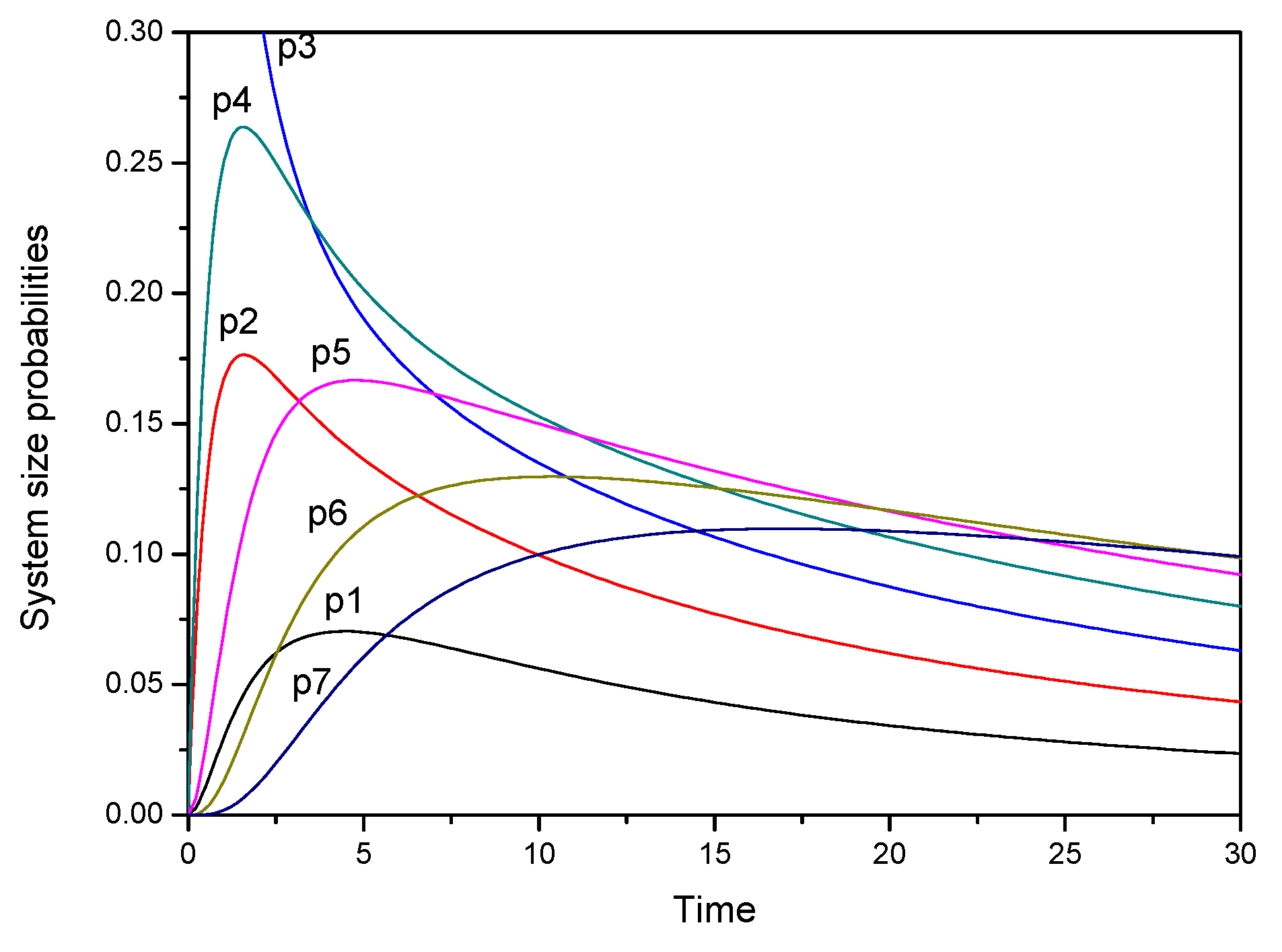1. Introduction
Let us consider the second order differential equation
where
and
are polynomials independent of
n,
is known as the eigenvalue parameter which depends on
[
1,
2] and
and
e are real parameters. In the self-adjoint form of (
1), the general weight function is given by
The parameters
d and
e in (
2) depend on three independent parameters
a,
b and
c. Consequently, we will have exactly six solutions of Equation (
1) known as classical orthogonal polynomials (COPS). Classical orthogonal polynomials and Sturm–Liouville problems are also related to symmetry (see [
3]). Classical orthogonal polynomials can also be characterized as finite COPS and infinite sequences. Jacobi, Leguerre and Hermite orthogonal polynomials are three well-known cases of infinite orthogonal sequences while the other three finite COPS are less familiar in the literature. In [
4], Masjed-Jamei characterized the finite cases and studied various properties. For details of this literature we refer to [
4,
5,
6,
7] and references cited therein. In [
4], these finite COPS are categorized as first, second and third classes, based on their connection with Jacobi, Hermite and Bessel functions, respectively. The R-Jacobi, R-Hermite, and R-Bessel polynomials can also be used to represent these classes of polynomials. Here, R- stands for Routh or Romonovski, because Routh [
8] and Romonovski [
9] introduced and studied these classes independently. For further details regarding this literature can be found in [
5,
6,
9] and references cited therein. In [
5,
6], Malik and Swaminathan called these R-Jacobi, R-Hermite and R-Bessel finite COPS as Type I, Type II and Type III COPS, respectively. The following
Table 1 gives details of all the six classical orthogonal polynomials.
Let
be a sequence of classical orthogonal polynomials. Then it satisfies the following three term recurrence relation
with
for
. COPS have lot of applications in mathematical biology, queueing theory and other fields of pure and applied mathematics. In this paper, we consider the applications of COPS, especially R-Jacobi and R-Bessel polynomials in birth and death processes. Before proceeding towards the main results, let us provide a short introduction about birth and death processes.
A special case of the continuous time Markov process is the birth and death process whose transition probabilities are defined as
and states are labelled by non-negative integers.
Let
and
be birth and death rates, respectively, for
and
. Then the transition probabilities
satisfy the following
Theorem 1 ([
10] Theorem 5.2.1)
. Transition probabilities satisfy the following Chapman–Kolmogorov differential equations It is well known that birth and death processes and orthogonal polynomials are related to each other [
10,
11].
Then, from Theorem 1, we have [
10] (p. 137)
and
The family of polynomials are called birth and death polynomials.
The following theorem describes the behaviour of zeros of birth and death process polynomials.
Theorem 2 ([
10] Theorem 7.2.5)
. The zeros of birth and death process polynomials belong to . In this paper, our objective is to find the bounds for the extreme zeros of the finite classes of orthogonal polynomials related to birth and death processes with the help of chain sequences.
Definition 1 (Chain Sequences [
12])
. A sequence is called a chain sequence if there exists a sequence such that- (i)
- (ii)
,
where the sequence is known as the parameter sequence for .
Let us recall the following well-known results, which will be useful to prove the main results of this manuscript.
Lemma 1 ([
13])
. The chain sequences associated with (3) and birth and death processes with transition rates and for are given by Theorem 3 ([
13] Theorem 2)
. Let be a chain sequence andwhere and , are the roots of the equation i.e.,Then the zeros of lie in .
In 1924, G. U. Yule [
14] considered the simplest model of birth and death processes. In [
15], quartic transition rates of birth and death processes have been studied. Recently, new Nevanlinna matrices for orthogonal polynomials related to cubic birth and death processes have been derived in [
16]. In [
13], bounds for extreme zeros of Laguerre, associated Laguerre, Meixner, and MeixnerPollaczek polynomials have been found by M. E. H. Ismail and X. Li. These polynomials are also related to birth and death processes. The above results motivate us to consider R-Jacobi and R-Bessel polynomials and relate them with the birth and death processes and derive the bounds for extreme zeros of these polynomials.
5. Birth and Death Processes Related to g-Fraction
In this section, we consider a special type of birth and death process with rates satisfying the condition
with
. Clearly,
is a chain sequence.
Applying Laplace transform of
as
in (
5) and (
6) with initial state
we have
which results in the following S-fraction
Combining (
25) and (
27) we have
This implies
which is the g-fraction. The relationship (
29) can be expressed in terms of ratio of hypergeometric functions [
18] (pp. 337–339) as follows
Again applying [
19] (Theorem 2.1) in (
29), we can conclude that the Laplace transform
of transition probabilities
can be expressed as the ratio of basic hypergeometric functions as follows
for
and
be such that
and
.
Let the
Nth convergent of the continued fraction (
28) be
where
and
are defined by
and
The polynomials in (
32) can be expressed as follows
We are interested to analyse (
30). For this we need to compute the roots of
. It can be observed that the
is zero when
is an eigenvalue of the following tridiagonal matrix
The eigenvalues of the above matrix are real and distinct [
20] as the above matrix can be transformed into a tridiagonal matrix which is real, symmetric and positive definite whose subdiagonal elements are nonzero. Therefore (
27) converges in the
s-plane cut from 0 to
∞ along the negative real axis. Let
be the roots of
. Then (
30) can be expressed as [
21]
Applying an inverse Laplace transform to the above expression results in
J. A. Murphy and M. R. O’Donohoe [
22] derived the following formula for
where
and
Using the formula (
35) we will find the transition probabilities for the following models.
5.1. Model(a)
In this model, we established the chain sequence related to R-Jacobi polynomials.
Clearly,
and
for
. Furthermore, it can be noted that
and
which is the chain sequence related to R-Jacobi polynomials.
Transition probabilities for this model are computed with numerical values in
Table 6 and time-dependent system size probabilities for model(a) are plotted in
Figure 1.
5.2. Model(b)
It can be easily seen that
and
for
. Furthermore,
and
which is the chain sequence related to R-Bessel polynomials.
Transition probabilities for this model are computed with numerical values in
Table 7.
Time-dependent system size probabilities for model(b) are plotted in
Figure 2.
5.3. Model(c)
It can be noted that
and
for
. Further
and
which is the chain sequence related to Laguerre polynomials [
13].
Transition probabilities for this model are computed with numerical values in
Table 8.
Time-dependent system size probabilities for model(c) are plotted in
Figure 3.










